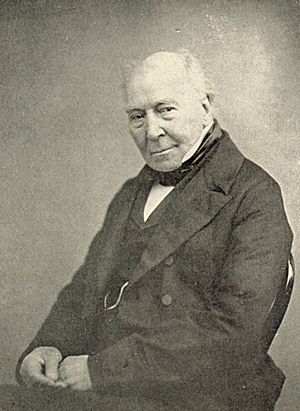William Henry Fitton facts for kids
William Henry Fitton (born January 24, 1780 – died May 13, 1861) was an Irish doctor and a scientist who loved studying rocks and the Earth. He was known as an "amateur geologist" because he learned about geology mostly on his own, not as his main job.
Contents
William Fitton's Life Story
Early Life and Education
William Fitton was born in Dublin, Ireland. He went to Trinity College in Dublin. He was a very bright student. In 1798, he won a special scholarship. The next year, he finished his studies there.
Around this time, William became very interested in geology. Geology is the study of Earth's rocks and how they are formed. He started collecting fossils, which are the remains of ancient plants and animals found in rocks.
Becoming a Doctor and Geologist
William decided to become a doctor. In 1808, he moved to Edinburgh, Scotland. There, he listened to lectures by a famous scientist named Robert Jameson. These lectures made him even more interested in nature and geology.
In 1809, he moved to London to continue his medical studies. He also studied chemistry. In 1811, he shared his findings about the rocks around Dublin with the Geological Society of London. He also talked about some rare minerals found in Ireland.
For a few years, starting in 1812, he worked as a doctor in Northampton. This job took up most of his time. In 1816, he earned his medical degree from Cambridge University.
Focusing on Geology
In 1820, William Fitton married a wealthy woman. This allowed him to move back to London and spend all his time on geology. He did a lot of important research.
Fitton's Strata Below the Chalk
From 1824 to 1836, Fitton studied the layers of rock in southeast England. He wrote a famous paper about his findings. It was called Observations on some of the Strata between the Chalk and the Oxford Oolite. People often call it Fitton's Strata below the Chalk.
In this work, he clearly showed how different rock layers were connected. He studied layers like the Upper and Lower Greensand. He also looked at the Wealden and Purbeck formations. His work helped other scientists understand Earth's history better.
Leadership and Contributions
William Fitton became a member of the Royal Society in 1815. This is a very old and respected group of scientists. He was also the president of the Geological Society of London from 1827 to 1829. He wrote many research papers for the society.
His home became a place where scientists would meet. When he was president, he held special Sunday evening gatherings. All members of the Geological Society were welcome to come and talk about science.
From 1817 to 1841, he wrote many articles for the Edinburgh Review. These articles discussed new ideas in geology. He also reviewed important books by famous geologists like William Smith (geologist), Charles Lyell, and Roderick Murchison. He also wrote Notes on the Progress of Geology in England.
In 1833, he published A Geological Sketch of the Vicinity of Hastings. This book described the geology around the town of Hastings.
Awards and Inventions
In 1852, the Geological Society gave him the Wollaston Medal. This is a very important award for geologists. His medal is now kept at the Geological Museum in Trinity College, Dublin.
Around 1825, William Fitton invented a toy called the thaumatrope. This toy makes two different pictures seem to blend into one when spun quickly. It was later made popular by another doctor, John Ayrton Paris. William Fitton passed away in London in 1861.
William Fitton's Family
William Fitton had three sisters: Sarah Mary, Elizabeth, and Susanna. Sarah and Elizabeth wrote a book together called Conversations on Botany. This book helped make the study of plants popular, especially for women.


